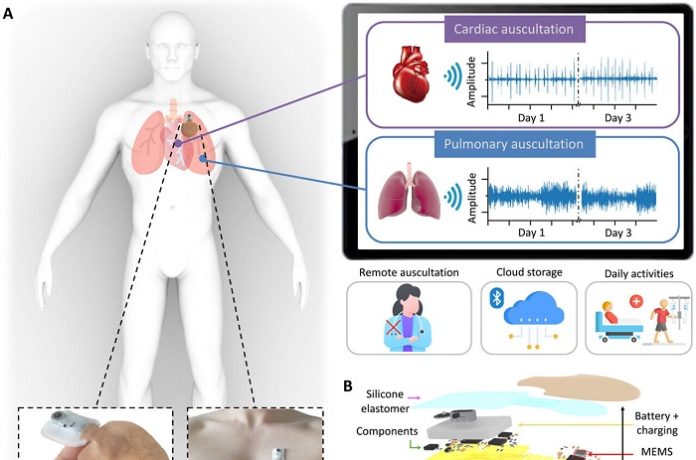Digital stethoscopes provide better results compared to conventional methods to record and visualize modern auscultation. Current stethoscopes are bulky, non-conformal, and not suited for remote use, while motion artifacts can lead to inaccurate diagnosis. Sung Hoon Lee and a research team in engineering, nanotechnology, and medicine at the Georgia Institute of Technology, U.S., and the Chungnam National University Hospital in the Republic of Korea described a class of methods to offer real-time, wireless, continuous auscultation. The devices are part of a soft wearable system for quantitative disease diagnosis across various pathologies. Using the soft device, Lee et al detected continuous cardiopulmonary sounds with minimal noise to characterize signal abnormalities in real-time. The team conducted a clinical study with multiple patients and control subjects to understand the unique advantage of the wearable auscultation method, with integrated machine learning, to automate diagnoses of four types of disease in the lung, ranging from a crackle to a wheeze, stridor, and rhonchi, with 95% accuracy. The soft system is applicable for a sleep study to detect disordered breathing and to detect sleep apnea.
Auscultation in the field of medicine
Chronic obstructive pulmonary disease (COPD) and cardiovascular disease (CVD) are predominant factors of mortality worldwide. The two pathologies form an umbrella term for diseases of the heart and lung, leading to the malfunction and restricted blood flow during breathing. While approximately 80% of COPD mortality occurs in low-to-middle income countries due to healthcare inaccessibility, accurate auscultation can be helpful diagnose the disease at an early stage and evaluating the treatment response. Similarly, heart sounds also facilitate diagnosis and the identification of vascular heart diseases.
Auscultation is the most basic and vital diagnostic method in medicine, due to its noninvasive, fast, informative, and inexpensive use. Since most stethoscopes cannot record the detected sounds, the process can be limited via conventional stethoscopes, making it difficult to share the outcomes to record abnormalities. As a result, some critical respiratory and heart diseases can be misdiagnosed or underdiagnosed. Digital stethoscopes that assist auscultation in real-time can covert acoustic sounds to electrical signals to amplify inaudible sounds via acoustic stethoscopes. In this work, Lee et al introduced a soft wearable stethoscope system for ambulatory cardiomyopathy auscultation via a class of methods based on advanced electronics, flexible mechanics, and soft packaging for cardiovascular disease, and respiratory monitoring.
Conventional stethoscope vs. the digital stethoscope
The team sought to maintain appropriate contact of the wearable microphone system with the skin. When compared to the commercial stethoscope, the thin and flexible digital stethoscope formed conformable contact for high-quality sound recording. Lee et al conducted experiments to compare the sound recording performance of conventional vs. digital stethoscopes, in which healthy subjects walked or stood with the device mounted on the chest and recorded sounds every five minutes. The device further demonstrated water-proof capabilities and breathability, for long-term use.
Detecting cardiac sounds in daily life and introducing a denoising algorithm for automated disease diagnosis
Since daily activities have diverse sources of noise, and can negatively affect recording sounds with a conventional stethoscope, clinicians perform auscultations in patients in a resting state. Lee et al demonstrated the performance of a digital stethoscope to regulate motion artifacts relative to the skin-contact quality by exploring a range of scenarios in which subjects mimicked a variety of real-life situations to show the influence of the measured sound quality. While the soft device allowed efficient sound recording, conventional stethoscope-like devices caused low-quality recordings of the heart and lung sounds. The team used additional filtering of the first-level cut-off frequencies to remove unwanted high-frequency noise.
The researchers studied wavelet transformation of heart, lung sound signals, and noise filtering to capture sounds of the body and the surrounding. They accomplished this with a threshold algorithm to suppress noise in digital signals. The work showed superior performance of the soft wearable system by detecting lung sounds and abnormalities from various diseases. The new stethoscope provided a crucial advantage for continuous real-time recording of high-quality sounds, and quantitative data via a convolutional neural network (CNN)-based machine learning, for automated disease classification. The team converged the smartphone app with machine learning to classify disease phenotypes in real-time.
Outlook
In this way, Sung Hoon Lee and colleagues developed a flexible, soft material noise-reduction mechanism and associated algorithm to fully realize a portable, continuous, real-time auscultation method with a wearable stethoscope. The team showed cardiopulmonary monitoring across multiple humans engaged in various daily activities. The soft wearable system is biocompatible and skin-friendly, with integrated deep learning, applicable for successful clinical studies and remote disease analyses, and suited for next-generation personalized biometric security systems.









